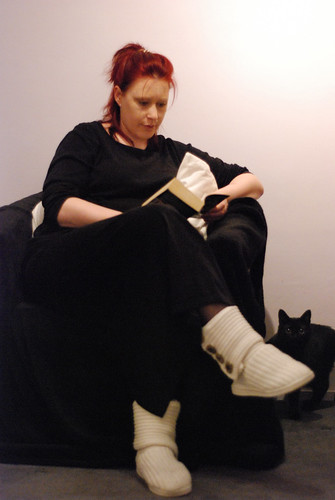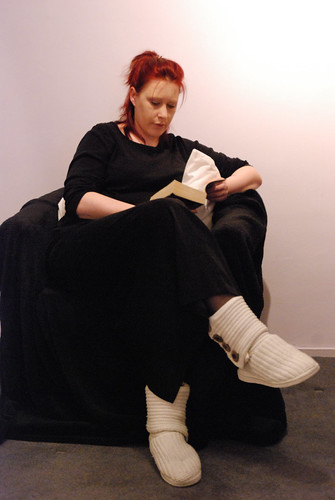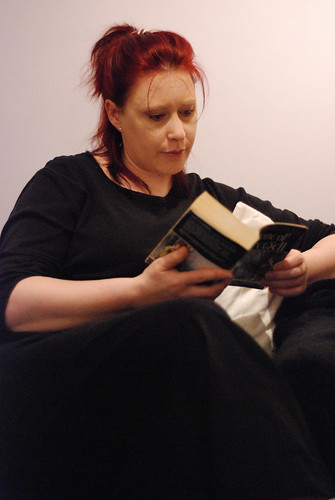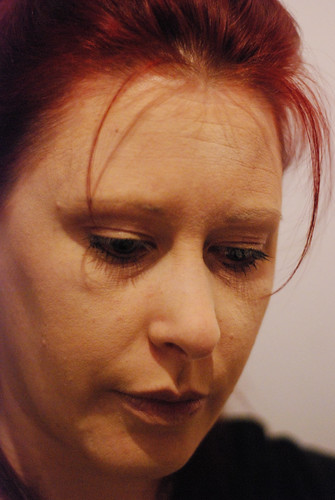Where: Inside the house, during the evening.
When: During the evening.
How: having learned that the quality of the lighting in the room was not suitable for what I required I added an extra lighting component to the setup by using an EX150 studio flash with a softbox mounted on the front of it.
This time instead of having the model sitting reading a book, we had a conversation as she was sitting on the chair and I shot the images when I thought it was appropriate. We had to sit for a while as she blinked a lot on the images whenever the flash fired and we had to change the power of the flash occasionally depending on how she was sitting.
I was much happier with the quality of the images this time around as the ISO was lowered and this allowed a less dusty image
Prime Lens 50mm
I started with the Prime Lens, working my way back across the room, composing as I went to obtain the correct positioning that I wanted. One of my fears was that, as I was going to be close up to her using the prime lens that I would have to find a position that meant I was not blocking the light but at the same time allowing her to light up by the flash.
I left the softbox in the same position and adjusted the head and flash levels as I went.
At first I had a few problems with the shutter speed as I was shooting at a speed slightly higher than the camera and flash synchronisation, so at first I was having the image cropped off by the shutter sync, again I had to adjust my positioning and the flash light levels down to a stop whereby I would achieve synchronisation without over exposing the image.
Close Up
Nikon D80, focal length 50.0mm (35mm equivalent 75mm), aperture f1.7, speed 1/180 second, ISO 100, Flash white balance, matrix metering, tripod mounted camera, 50mm lens,EX150 Flash Head with Softbox
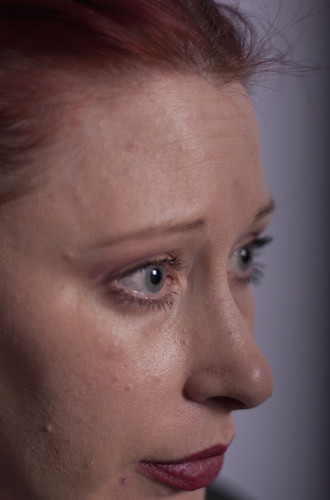
I was relatively happy with this shot, although the thin aperture means that the background tails off into black. However it gives great definition to the eyes and the tight close crop of her face leaves you with her eyes as the main point of focus.
After looking at the image on the screen, I decided that I would like to see a black and white version of the image. I found after a short bit of experimentation that I preferred a version with a High Contrast Red Filter as it did not distract from her face, other filters had a tendency to show up too much facial definition.

Head and Shoulders
Nikon D80, focal length 50.0mm (35mm equivalent 75mm), aperture f1.7, speed 1/180 second, ISO 100, Flash white balance, matrix metering, tripod mounted camera, 50mm lens,EX150 Flash Head with Softbox

It took a bit of fiddling with the lights to increase the power of the flash without over exposing her face. After a few shots I found a setting that I liked and shot of a few images of her as we spoke.
I like the colour definition and again I kept the aperture at f1.7 to create the thin depth of field.
Three Quarter Length
Nikon D80, focal length 50.0mm (35mm equivalent 75mm), aperture f1.7, speed 1/180 second, ISO 100, Flash white balance, matrix metering, tripod mounted camera, 50mm lens,EX150 Flash Head with Softbox
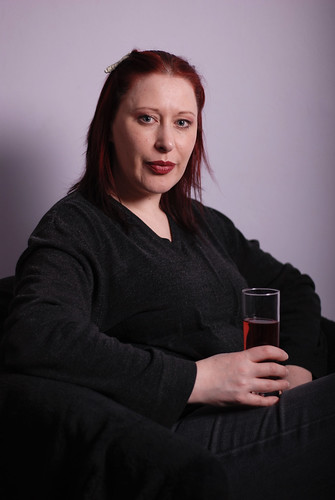
The light proved to be good at allowing her to be defined against the black and not have her head pop out of a black shape. Again I am pleased with the aperture which was focused on her eyes allowing the depth of field to isolate her from the background while still giving her shape and form.
Full Length
Nikon D80, focal length 50.0mm (35mm equivalent 75mm), aperture f1.7, speed 1/180 second, ISO 100, Flash white balance, matrix metering, tripod mounted camera, 50mm lens,EX150 Flash Head with Softbox
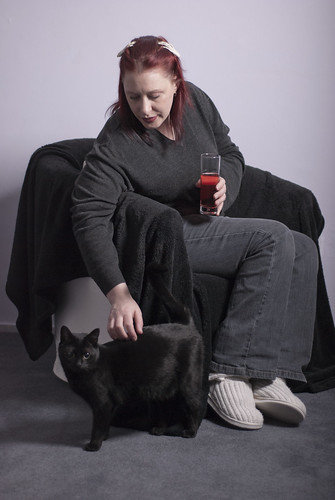
I was very surprised to find that the colour was almost over saturated when I looked at this image on the screen. I dropped the saturation back to a negative level as I found that the colour was distracting and it was pulling away the eye. I am not sure about having the cat in the image, but at the time he would not leave the room.
Lessons Learned.
Using a greater amount of light allowed me to drop the ISO level down to the cameras minimum, this gave me time to compose as I did not have to worry about the model moving and creating blur. At times I did find that the images were over saturated, probably due to the amount of light.
After I had moved the camera back to its furthest away position for the prime lens, I swapped the lens on the camera for a telephoto lens.
Telephoto Lens
Close Up.
I looked over a couple of lenses before using the 70-300 as it had the best choice of aperture, some of the other lenses I have had limited apertures as I felt that they did not give me a shallow enough depth of field for what I wanted.
Nikon D80, focal length 240.0mm (35mm equivalent 360mm), aperture f5.5, speed 1/125 second, ISO 100, Flash white balance, matrix metering, tripod mounted camera, 70-300mm lens,EX150 Flash Head with Softbox
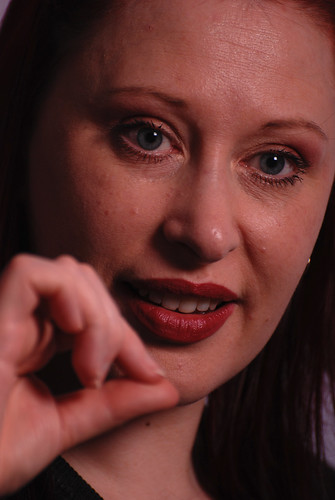
I was very surprised to see on the screen that the image was not too shallow, as at first I thought I would get the defined depth of field that I wanted. Then I remembered that the telephoto lens can flatten the depth of field due to its optics.
I almost find this image a little too dark, due to the framing of her hair in the image.
Head and Shoulders
Nikon D80, focal length 122.0mm (35mm equivalent 183mm), aperture f4.8, speed 1/125 second, ISO 100, Flash white balance, matrix metering, tripod mounted camera, 70-300mm lens,EX150 Flash Head with Softbox
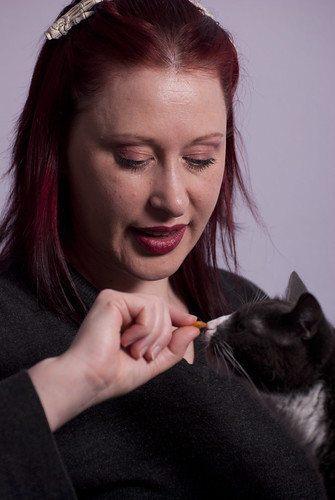
Black and White Version
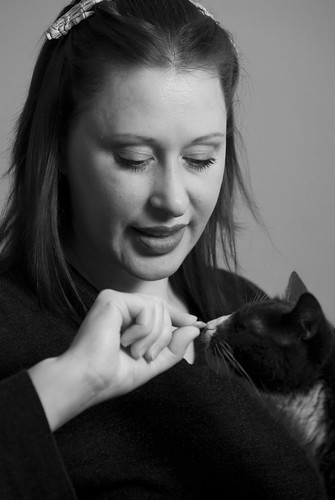
As I pulled the lens back to 122mm I was able to move the aperture to f4.8 without affecting the shutter speed. I carefully framed her head and shoulders into the frame, but I did not like the front on stance that she took. I had her turn her position back to the original position of having her right shoulder forward and turning her head towards the lens.
I again had to change the strength of the flash as it was causing the front of her forehead to be over exposed and very blown out white. After repositioning the head down slightly and tiliting it off to the left I found the light to be better.
I like the framing of her hand in this position as it leads the eye into the frame and from there the eye moves up her face and to her eyes.
Three Quarters
Nikon D80, focal length 70mm (35mm equivalent 360mm), aperture f4.5, speed 1/125 second, ISO 100, Flash white balance, matrix metering, tripod mounted camera, 18-70mm lens,EX150 Flash Head with Softbox

I swapped the lens again as although both lenses had a 70mm position I wanted to flow down the focal length rather than have three images using the 70-300mm lens and one using the 18-70mm lens. The only real affect between the two lenses at the same focal length was a slight f-stop difference.
The shorter focal length lens was ideal for the three quarter and full length shots. Here I was able to frame her sitting, the model was a bit self conscious about her hands, so giving her a glass allowed her to have something to hold and feel comfortable with.
Full Length
Nikon D80, focal length 38mm (35mm equivalent 57mm), aperture f4.2, speed 1/125 second, ISO 100, Flash white balance, matrix metering, tripod mounted camera, 18-70mm lens,EX150 Flash Head with Softbox
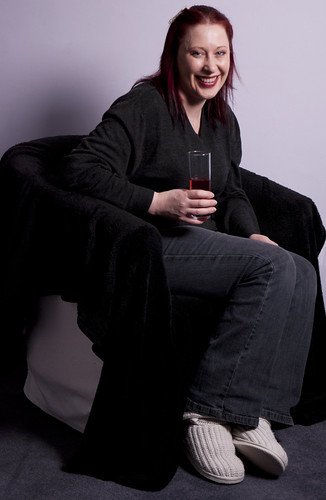
I think as this was the last shot, she had relaxed and was smiling as it was almost over.
The only real problem I have with this image is that again she is starting to be lost in the depth of a black shape which starts to merge with the shadows behind her.
Lessons Learned.
I did learn that there is quite a bit of difference in the final quality of the portrait which depends on the aperture of the lens I was surprised to find that the telephoto lenses allowed for almost the same amount of separation and depth of field as the prime lens which was something which I had no expected.
I was a lot happier this time doing the exercise as I found that I approached this exercise better prepared and although I was self critical that the quality of the images, I found less images to reject from the pile.
I was also happy that I had used both the prime and the telephoto lenses so that I could contrast and compare the two techniques and the images which resulted from them.
The image that I am most fond off, after a little retouching;

